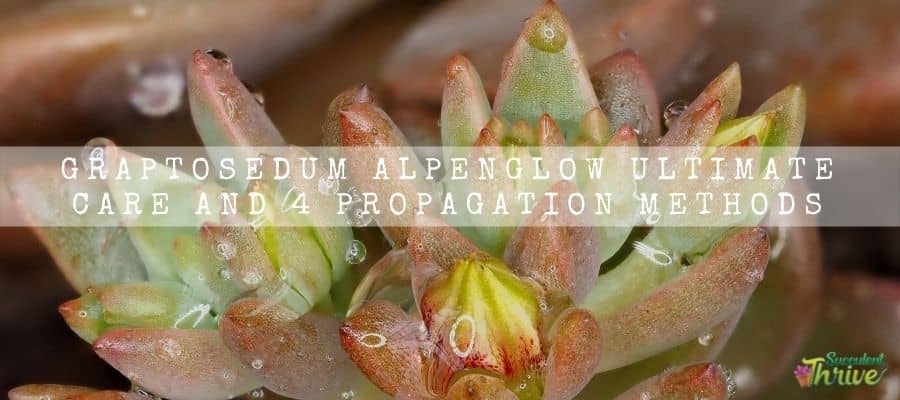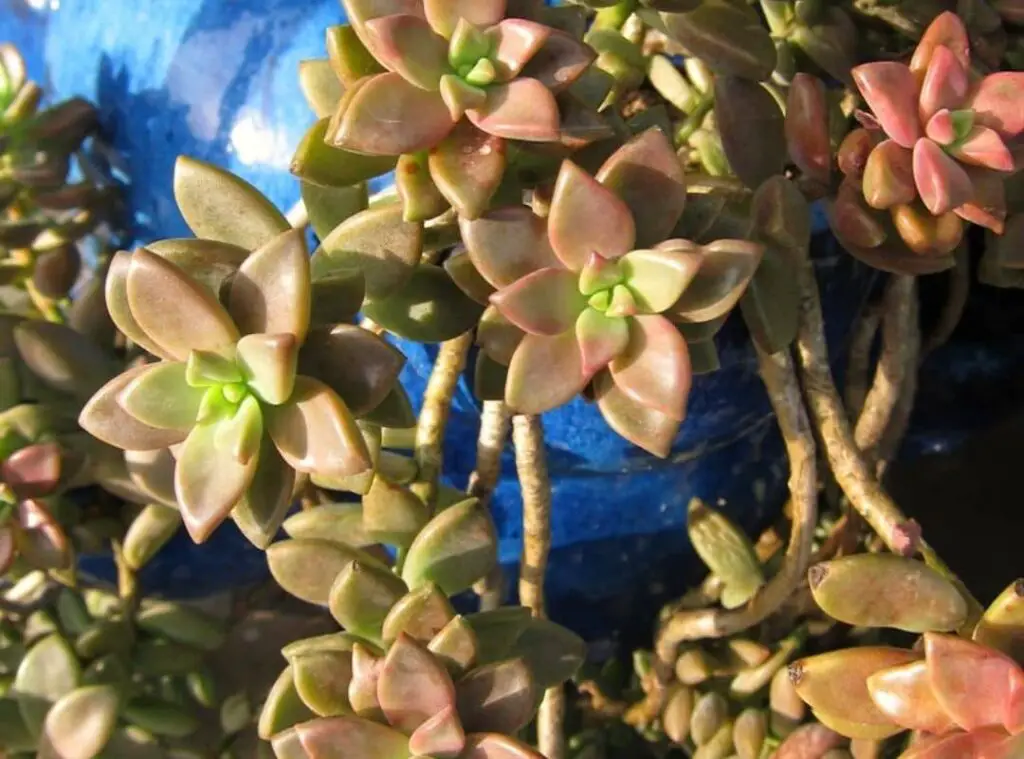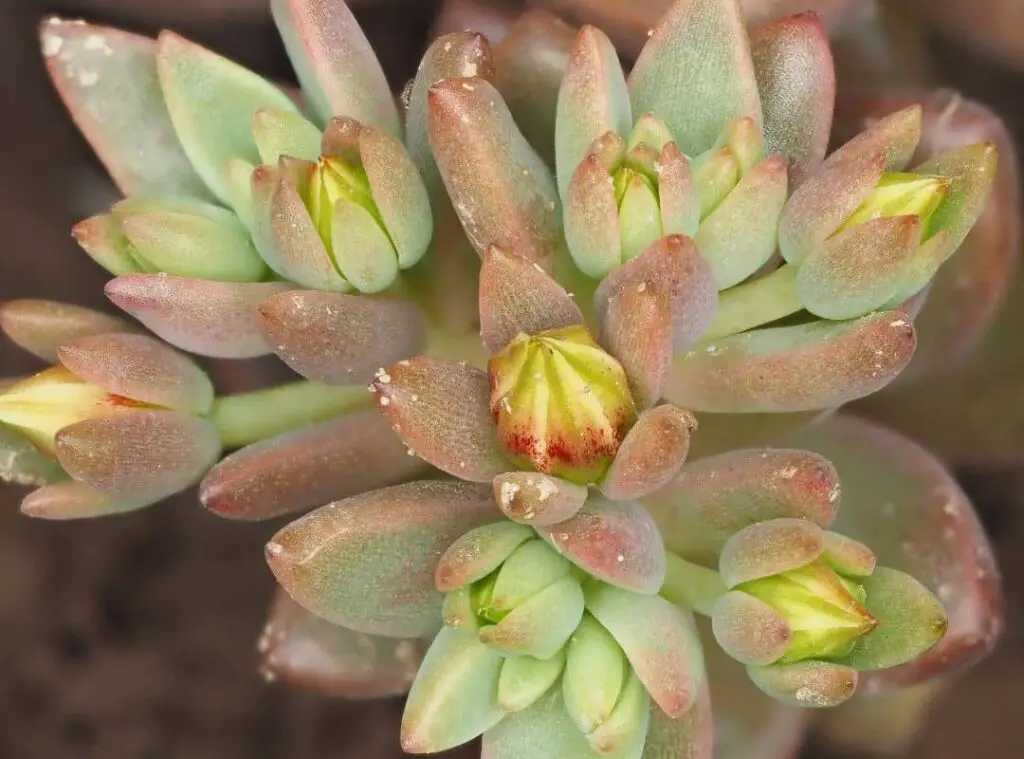Graptosedum Alpenglow is a tiny and cute succulent. They are renowned for their reddish, bronze feature in their foliage. You could expect them to flower in early spring. They are native plants in Mexico.
They require the same care as the other succulents. Further you could conduct the regular propagation methods when propagating them.
These are easy to care for plants. Moreover, they would be a great pick for your garden as well.

How do I identify a graptosedum alpenglow?
Their matured leaves could be either purple, red or orange. On the other hand, their young leaves could take a green color. Further their shape would be elliptic along with a pointed top.
Moreover, you could spot a concave shape underneath the leaf. Their flower would be in yellow, and they would consist of petals oval with pointed ends.
All together there would be 4 petals. Usually, the flowers would form on the stems.
Size
Alpenglow would usually rise to 15 cm in height. Further, they would be 30.5 cm wide. They could spread out to fill the pot to cover your pot or even garden space.
Their leaves would be 2.5 cm (1 inch ) in length and they are usually flat.
Growth
Alpenglow is usually a slow growing set of plants.
One look care guide
| Botanical Name | Graptosedum alpenglow |
| Common Name | Alpenglow plant |
| Plant Type | Succulent |
| Mature Size | 15.0 cm in height 30.5 cm widespread |
| Sun Exposure | Full sunlight to Partial sunlight |
| Soil Type | Well-draining |
| Soil pH | Neutral |
| Bloom Time | Spring or Summer |
| Flower Color | Yellow |
| Hardiness Zones | 10a |
| Native Area | Mexico |
| Toxicity | Non-Toxic |
| Average price | 5 USD |
How do you take care of a graptosedum alpenglow?
Light Requirement
It is important that you provide them with plenty of sunlight so that they can enhance their leaves color.
Best is to let these plants gain full sunlight during the morning hours and the partial sunlight during the rest of the day.
Avoid exposing these plants to direct sunlight. Unless there could be sunburns in the foliage.
Temperature and humidity
Alpenglow plants would thrive well in warm temperatures so that they can grow optimally. Best temperature to grow these plants would be 15-30 degrees Celsius.
Further, avoid exposing these plants for temperatures below 5 degrees Celsius as they could cause root rots in the plant. It could be even fatal on the plant too.
Is it cold hardy?
Alpenglow plants are not cold hardy plants.
USDA Hardiness Zone
These plants would prefer to grow in USDA zones 10a (minimum 30 degrees Fahrenheit – 1.1 degrees Celsius).
Watering Requirement
Alpenglow plants would reward you with attractive and aesthetically beautiful plants if you take care of them well.
Their watering requirement is similar to other succulents. It is mandatory that you water them properly so that they can grow well.
Do not leave them stranded in water. Avoid watering them in excess as well. Best is to apply the soak and dry method when watering them so that you will not end up over watering the plant.
Soil Requirement Type / pH
You should grow these plants in a well-draining soil mix and that is very crucial when you are growing them properly.
If you leave your succulent to be in waterlogged situations, it will make your plant mushy and rot.
Ideally you could go ahead and plant them in a premade succulent soil mix.
Alternatively, you could grow them in a soil mix which you had made on your own. If you wish to make a soil mix on your own, the ideal ratio should be 1:1 between soil to perlite or sand.
In case, if you think your soil mix is not well draining you could consider adding more perlite or sand.
Flowering and Fragrance
In terms of flowering, they would usually produce flowers which are yellow in color. Further those flowers would consist of four petals.
You could spot those flowers forming on stems. You could expect them to flower in spring and summer.
There are no specific fragrance to these flowers

Pot size Potting and Repotting
You could easily grow these plants in containers. However, you should make sure that the pot you have selected contains enough draining holes.
Further as aforesaid, it is important that you are growing them in a well-draining soil mix. Further you need to consider changing the soil mix when repotting.
Moreover, you could consider adding little stones, pebbles to the bottom of the pot.
Ensure that you report the Alpenglow plants in a timely manner. If you spot your plants roots have formed out from the pots, you could consider repotting them.
Having said that, it is normal for these plants to outgrow from the pots. However, when you conduct repotting, best is to use a fresh dry soil mix.
Once you repot them, skip watering them for about a week. That is because, if there are any damaged roots here, they could rot in the water, hence why you need to give them some time so that they can heal.
Where to Plant
Alpenglow plants are not cold hardy plants. As such, if your plant gets exposed to temperatures below 30 degrees Fahrenheit ( -1.1degrees Celsius), I urge you to grow them in a container which you could easily shift indoors.
When growing them indoors, you could supplement them with a grow light. Best is to plant them somewhere where they expose for full sunlight to partial sunlight.
When you are growing them in the garden, ideally you need to locate them somewhere where they get six hours of sunlight daily.
When growing them indoors, you could grow them in a place where they can get plenty of sunlight. It could be ideally a bright sunny window.
Fertilizer and time of year
When it comes to fertilizing, I would recommend you feed them during their growing season. As such it could be the beginning of the spring or fall.
That will give them a boost. You could feed them once every week. You could ideally use a balanced or low nitrogen fertilizer.
If you want to do it easily, you could use a liquid fertilizer which you have diluted to quarter strength.
Dormancy
Alpenglow plants are summer dormant plants.
Can be toxic to pets
These plants are nontoxic plants.
Common bugs and illness issues
You will have to encounter mealybugs, aphids and mollusks attacks when growing these plants.
When you come across a situation, it is important that you treat them quickly and get rid of them.
In addition to that, chances are that your plant will suffer from root rots as well. You could quite commonly spot it when there are high humidity levels.
In addition to that, etiolation would be one more common problem that your plants will go through.
To overcome this, you need to make sure that you let these plants gain adequate sunlight levels.
In case your plant is already suffering from etiolation, you could consider pruning the stems. Further you should relocate them to a place where they can gain enough sunlight.
Apart from that, you will come across situations where your Alpenglow plant will be shedding leaves. It could be most probably due to their natural aging.
Particularly the leaves at the base of the plant tend to drop. In case, if you spot your succulent upper part new leaves fall, it could be due to over watering.
Moreover, always check whether the soil is dry before you water these plants. Further ensure that excess water is draining through the draining holes.
In case if your Alpenglow plant is lacking enough water, they would tend to become wrinkled and discolored. Once you start watering them, they will revive.
In terms of pest attacks, mealybugs and aphids are a couple of annoying bug types which could create trouble for these plants.
They usually feed on the plant sap. When they attack the Alpenglow plants, you could spot their yellowed wilted leaves, black sooty mold.
Not only that but also you could see ants occupying the plant too.
To treat them, you could use an insecticidal soap. If the mealybug attack is on a minor level, you could dab the insect with a q tip soaked in rubbing alcohol.
Further you could deter mealybugs and aphids by planting worm castings. Apart from that it would help to improve the soil aeration and tilth as well.
Moreover, it would help to increase the moisture retention and make it more resistant towards the diseases as well.
Root rot is the worst thing which could happen for your Alpenglow plants. If you leave your plant in moist conditions, it will start decaying.
You could mainly spot the rot that is taking place in the roots. However, it could happen in any part of the plant. further it could make your plant more vulnerable for bacterial infections as well.
To prevent this, you need to always keep the plant dry. Avoid pouring water at the plant and instead water the soil. Do not forget to grow them in a sandy soil since it will not retain excess water.
In case your Alpenglow plant is already rotting, you could try saving it by trimming off the rotten parts of the plant. To do that you could use a sterilized knife.
Once you cut them, let those cut edges heal and after that you could consider transplanting them.
On the other hand, if the root rot has occurred in your plant on a significant level, best would be to obtain healthy leaves and stems and use them for propagation.
Special Care tips
Alpenglow plants are easy to care for and they do not generally require any special care treatment from you.
Having said that, you should make sure that you fulfill all its basic growing requirements so that they can grow well.
In addition to that, you could do necessary pruning particularly if your Alpenglow plant has etiolated.

How do you propagate a graptosedum alpenglow?
You could easily propagate the Alpenglow plants. You could try several methods to do it. You could propagate the Alpenglow plants by using their leaves, seeds, offsets or even their stem cuttings.
How to propagate Alpenglow plants by leaves?
- First obtain a healthy leaf from the Alpenglow plant.
- When you obtain the leaf, make sure that you are obtaining the whole leaf from the plant. Literally there should not be any leftover of the leaf on the plant.
- when you use the whole leaf, it will ensure that your propagation process will succeed.
- After that to keep those leaves in a dry place for a few days.
- That will allow them to become callous.
- After that you could locate them in a well-draining soil mix.
- You may start watering them when their soil is dry.
How to propagate Alpenglow plants by stem cuttings?
- When you use the stem cutting method to propagate these plants, you could first snip off a stem from the mother plant whilst using a clean knife or even scissors.
- Let it become callous and after that you could transplant them in a well-draining soil mix.
- You may water them once their soil is dry.
How to propagate Alpenglow plants by offsets?
- You could use offsets to propagate the alpenglow plants.
- However, you will have to wait for several years until they produce offsets. Once they produce offsets, you could start the process by removing them whilst using a sharp knife or scissors.
- Once you remove the offsets, you should clean the extra soil from it to allow it to become callous.
- Finally you should place them in a well draining soil mix. You could start watering them when their soil is dry.
How to propagate Alpenglow plants by using seeds?
- As aforesaid, these plants are a slow growing set of plants.
- Even though it is possible to propagate them by seeds, I would not recommend this option as you cannot rely on their results.
- However, you could try this method on the outdoor grown Alpenglow plants. You simply have to plant the seedlings in a well-draining soil mix
Read Next : Rat Tail Cactus Propagation | 2 Effective Methods For You |
